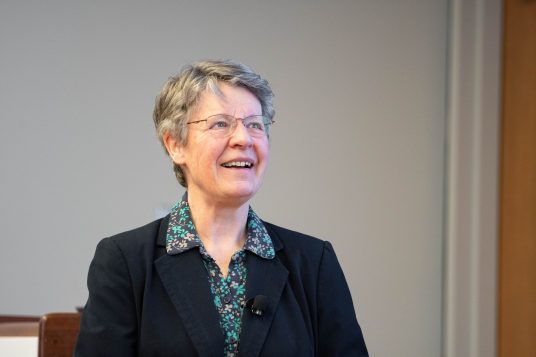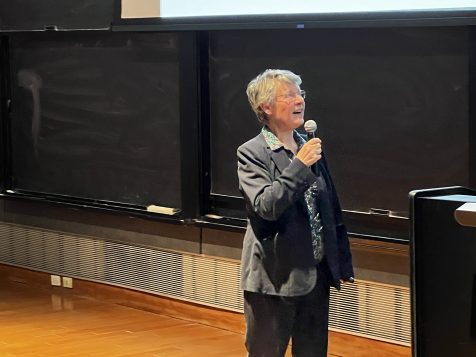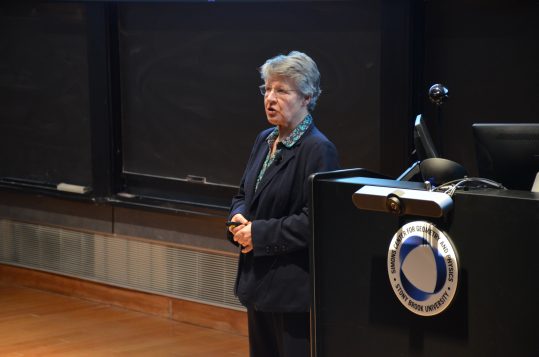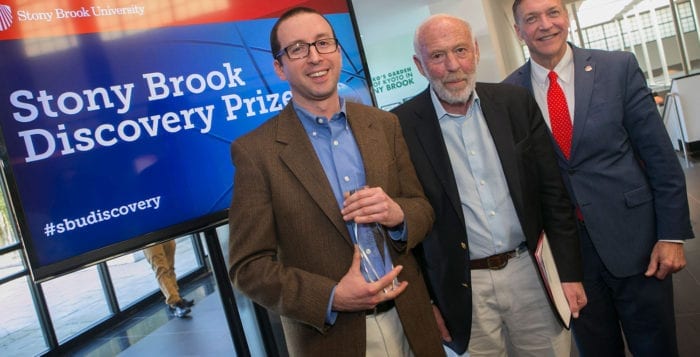By Daniel Dunaief
It wasn’t easy, back in the late 1960’s for astrophysicist Jocelyn Bell Burnell, to discover pulsars, which are rapidly rotating neutron stars that emit detectable radio waves. So it only seems fitting that the famous and award-winning scientist, who is now a Visiting Academic at the University of Oxford, might run into obstacles when she came to Stony Brook University’s Simons Center for Geometry and Physics to deliver a Della Pietra Lecture to the public.
The recent snowstorm, which canceled classes and events at the university for a day, also pushed back her talk by 24 hours. When the delayed talk began, Bell Burnell contended with a microphone that cut in and out. “It might be designed for a male voice,” Bell Burnell joked. Combining humor, accessible scientific detail, and a first-hand narrative, she delighted and inspired a crowd ranging from local high school students to Stony Brook professors.
“Her talk was refreshing and different,” said Marivi Fernández-Serra, Professor in the Physics and Astronomy Department and at the Institute for Advanced Computational Science at SBU. “I loved that it was both a personal story and a physics talk.”
Luis Álvarez-Gaumé, Director for the Simons Center for Geometry and Physics, recruited Bell Burnell for a three-part lecture series that included a talk for high school students and one for faculty and advanced graduate students.
Her talks were “very inspiring,” said Álvarez-Gaumé. Bell Burnell is “very sharp, extremely intelligent and easy to talk to.”
Humble beginnings
Born in Northern Ireland, where, Bell Burnell said, “Catholics and Protestants fight each other,” she earned her bachelor’s degree in Glasgow, Scotland.
Bell Burnell endured a tradition where the men whistled, stamped and made cat calls when a woman entered the room, which, in lecture halls with wooden floors, meant she heard considerable noise. She learned to control her blushing because “if you blushed, they’d only make more noise.”
Bell Burnell had one female lecturer, who survived one class and then quit. When she got to Cambridge to do her PhD, she had the wrong accent, came from the wrong part of the country and was “clearly heathen-educated,” she said. “It was quite daunting.”
Surrounded by young men full of confidence, she thought the university made a mistake in recruiting her and that she would probably get thrown out. Until that day arrived, she decided to work her hardest so when they did, she won’t have a guilty conscience. Her strategy, she said, was to “do your best until they throw you out.”
Hard work
Working with five other people for two years, Bell Burnell helped build a radio telescope at Cambridge to search for quasars, which are enormous black holes that release energy and light. When quasar jets interact with gas around the galaxy, they emit radio waves. The data in the search for quasars came out on long rows of red ink paper charts that she had to go through by hand.
By the end of her survey, Bell Burnell had gone through about 5 kilometers (or over 3 miles) of paper. She discovered an odd signal she couldn’t explain, which could have been radio interference. Recalling she had seen something like it before, she checked and found that it was in the same place in the sky.
When she conferred with her thesis advisor Anthony Hewish, he told her she needed to enlarge the signal by increasing the speed of the data collection.
For the first 10 days, she didn’t find anything.
“The thing had gone way,” she recalled. “That’s the grad student’s [i.e., her] fault. If you’re thinking of being a grad student, go ahead and go for it. You will get the blame for things that aren’t really your fault. Your thesis advisor has to vent their fury somehow.”
She persisted with these high-speed recordings until she got one. After pondering the signal for months and speaking with other astronomers, she found another signal the day before Christmas.
Bell Burnell was planning to leave the next day with her boyfriend to visit her parents, where the couple prepared to announce their engagement.
“I kind of have to be there,” she laughed.
At 2 a.m., she heard the pulse at a slightly different repetition rate in a different part of the sky. During her absence, her thesis advisor kept the survey running. When she returned, she found a pile of charts on her desk.
Hewish told her to go back over the charts and found occurrences of these patterns. Bell Burnell and her advisor worked with another radio astronomer and student to see if other researchers could see the same signal.
When they didn’t, the two academics started walking away. The other student, however, stayed with the equipment and found the same signal. He had miscalculated when his telescope would be able to see the pulsar by 15 minutes.
“If he had miscalculated by an hour and 15 minutes, we would have all gone home,” Bell Burnell recalled.
What Bell Burnell had found — first with the unusual signal in the paper and then with a careful search for other signals — were rotating neutron stars that spin like a lighthouse and that emit pulses of radiation. Scientists have now catalogued over 3,000 of them.
The pulsars are “fantastically accurate time keepers,” she said, losing only about a second of time since the age of the dinosaurs.
You don’t want to visit
Pulsars have numerous compelling properties. The neutrons that make up a pulsar are so dense that a thimble full of them weighs as much as seven billion people. To climb a one centimeter mountain would require effort comparable to reaching the peak of Mount Everest.
“It’s not recommended to go to one of these,” Burnell said.
The force of gravity is so strong that an object falling from a few feet would hit the surface at half the speed of light.
Attendees react
Fernández-Serra, who, among others, described Bell Burnell as “a rock star,” appreciated how the guest speaker was an “extremely dedicated and hard worker and also a very sharp student. She went above and beyond what her advisor had asked her to do and was persistent in pushing for what she thought was something special. Thanks to that, pulsars were discovered.”
While science has made huge strides in its treatment of women since the 1960’s, Fernández-Serra still sees opportunities for improvement. “The science community values aspects that are more commonly found in men: loud voices, quick opinions, more presence in the room (height actually matters a lot!!!),” she said, and added that science would benefit from valuing the opinions and thoughts of people who are introverted, mild-mannered and cautious decision makers.
Rosalba Perna, Professor in Physics and Astronomy at SBU, believes “we still have a long way to go” in correcting various unconscious bias.
Perna, who conducts part of her research on pulsars in her work on neutron stars, suggested that Bell Burnell’s description of pulsar’s extreme gravity “still leaves me in awe any time I think about it!”
Neelima Sehgal, Associate Professor in Physics & Astronomy at SBU, said the technical talk was “of particular interest to our female graduate students who asked a number of thoughtful questions” while the high school students almost filled the big auditorium at the Simons Center.
“It was pretty great that we were able to bring her to Stony Brook,” said Sehgal.








